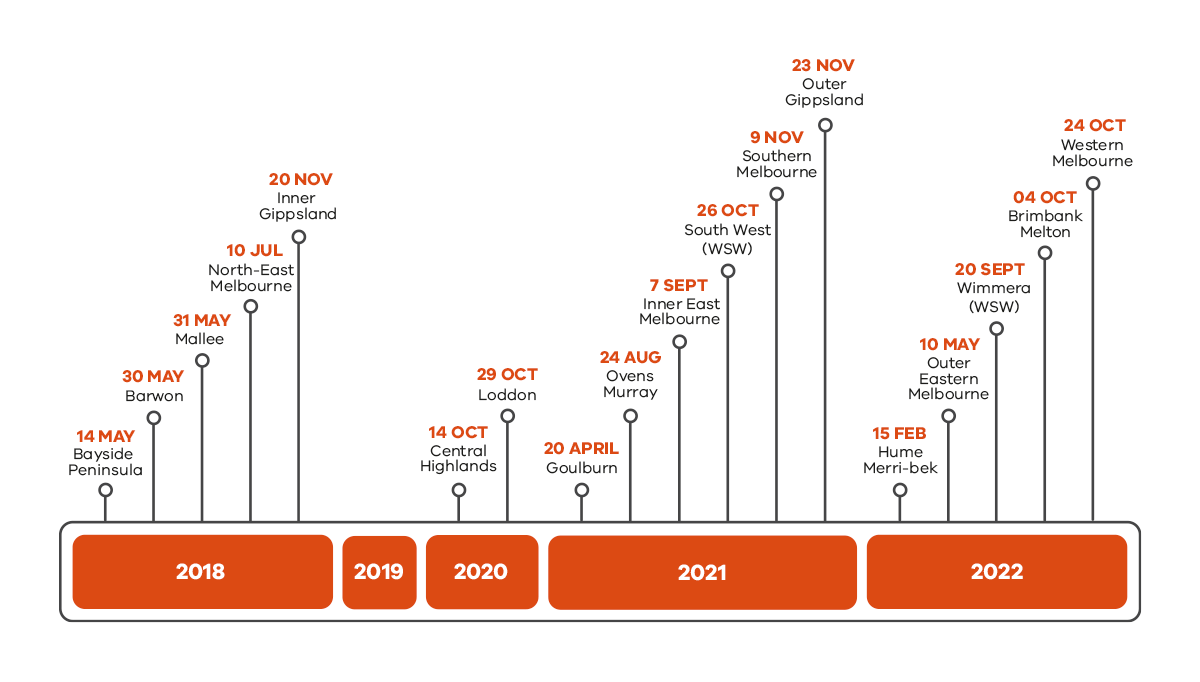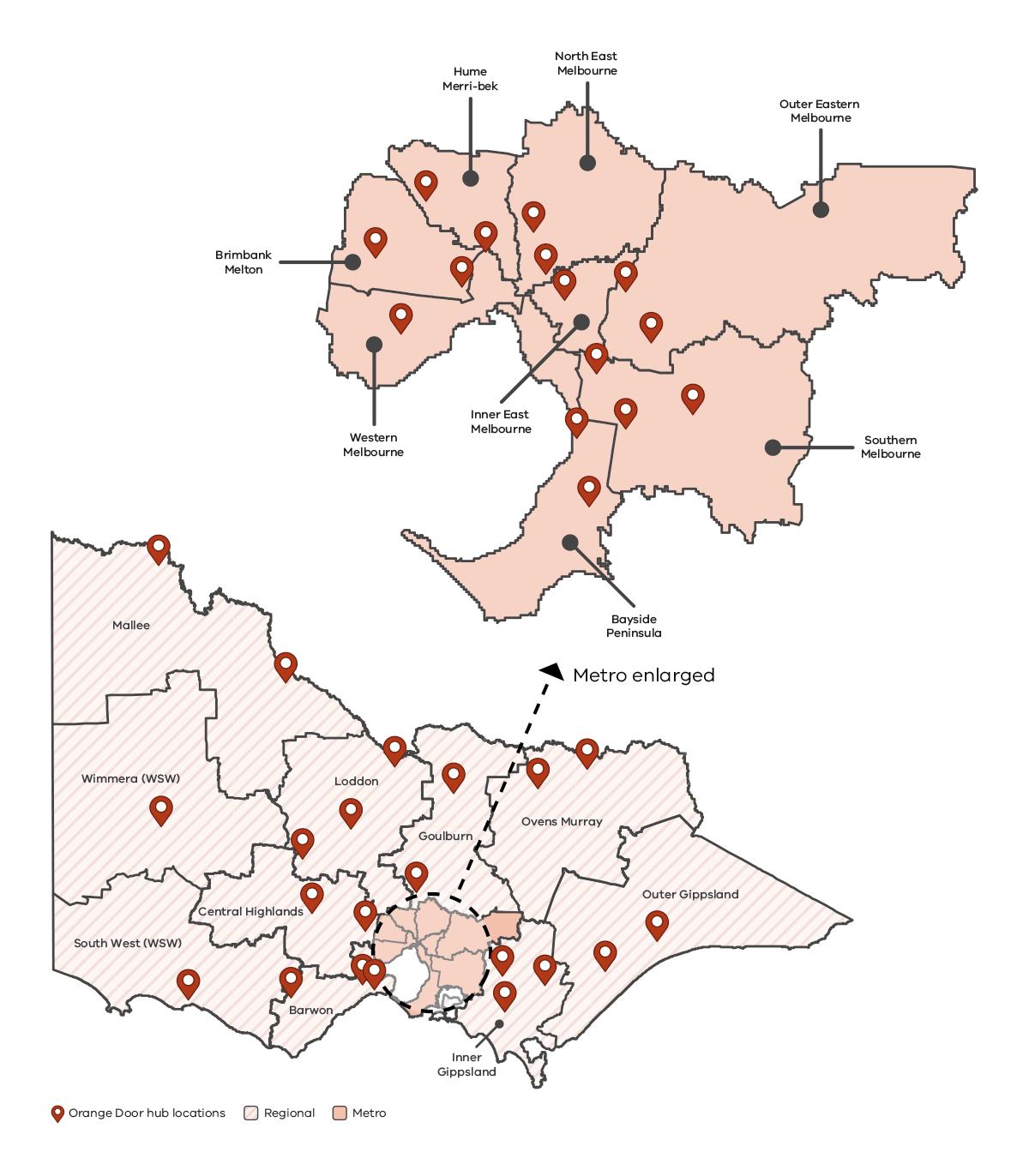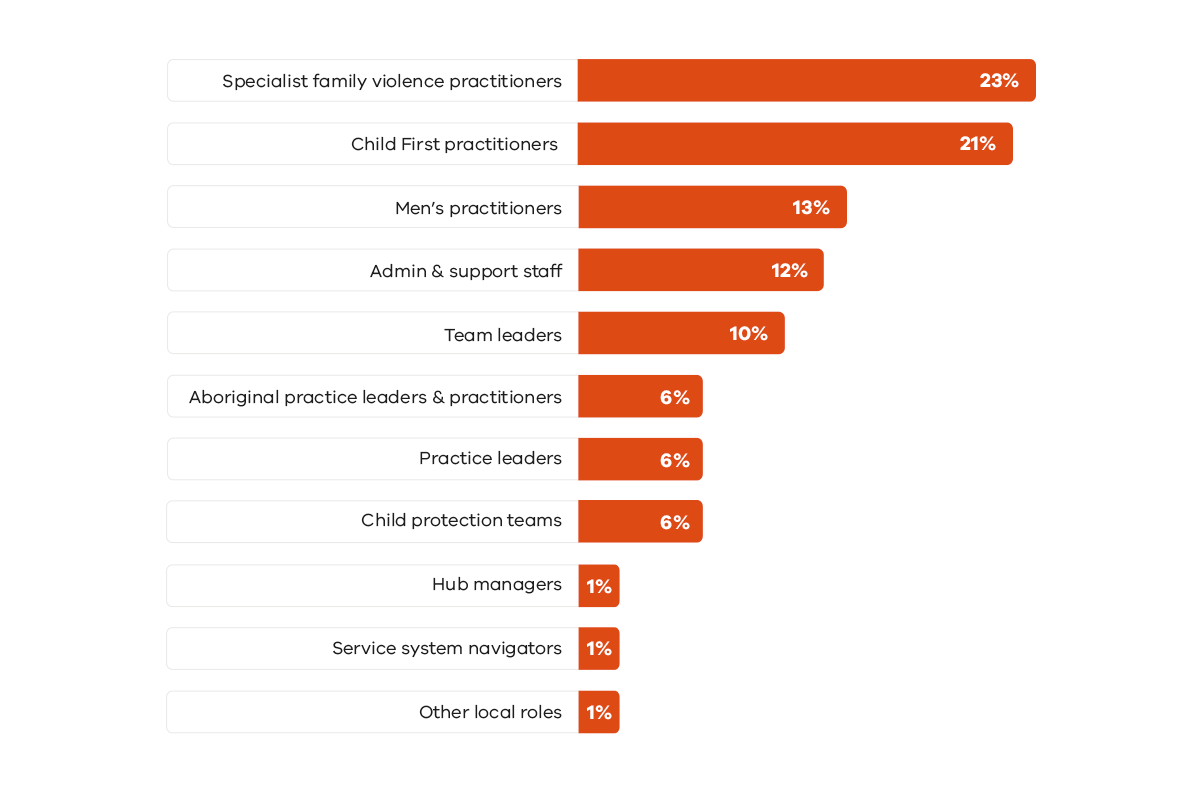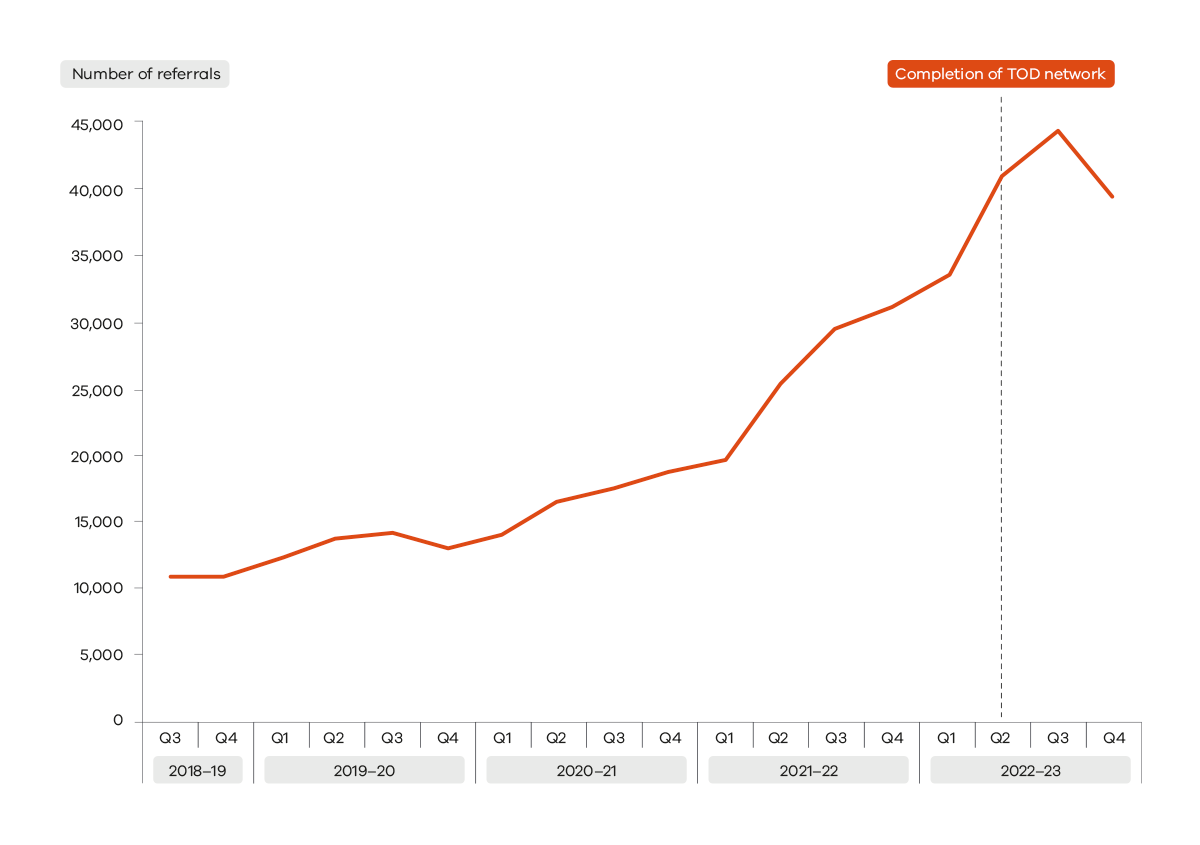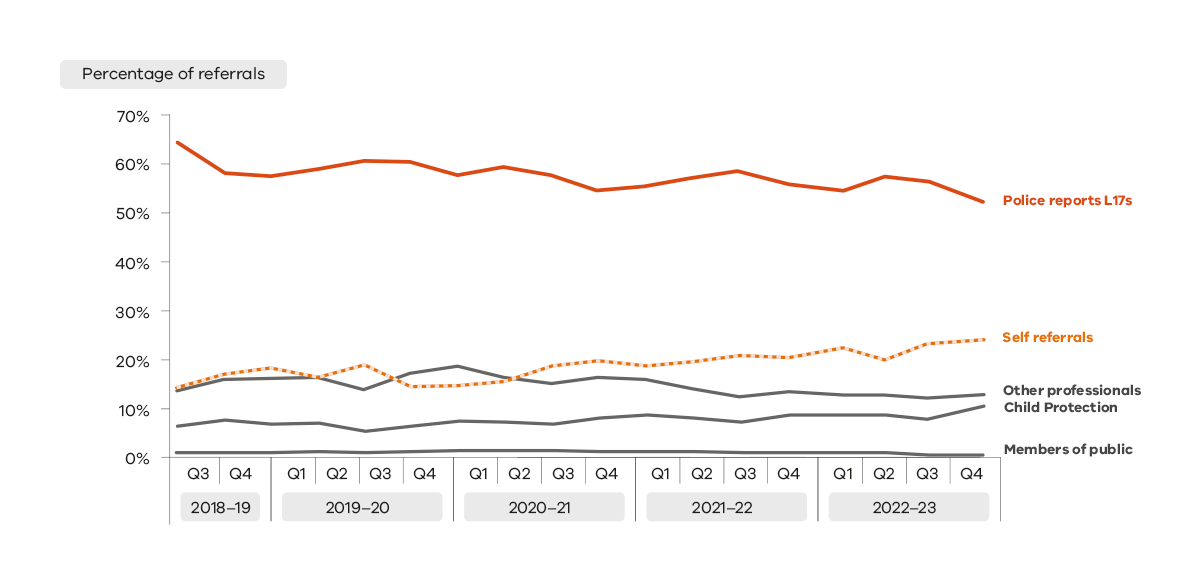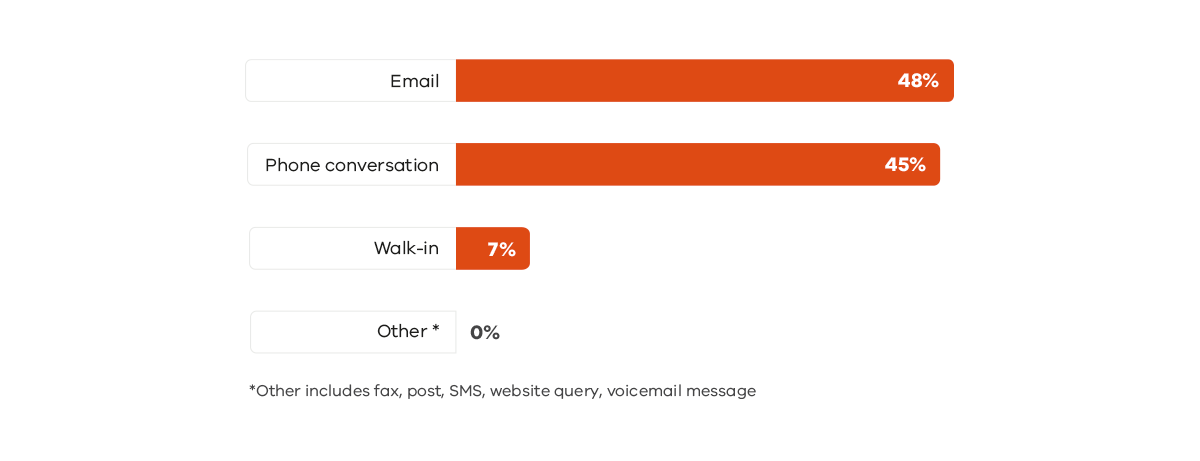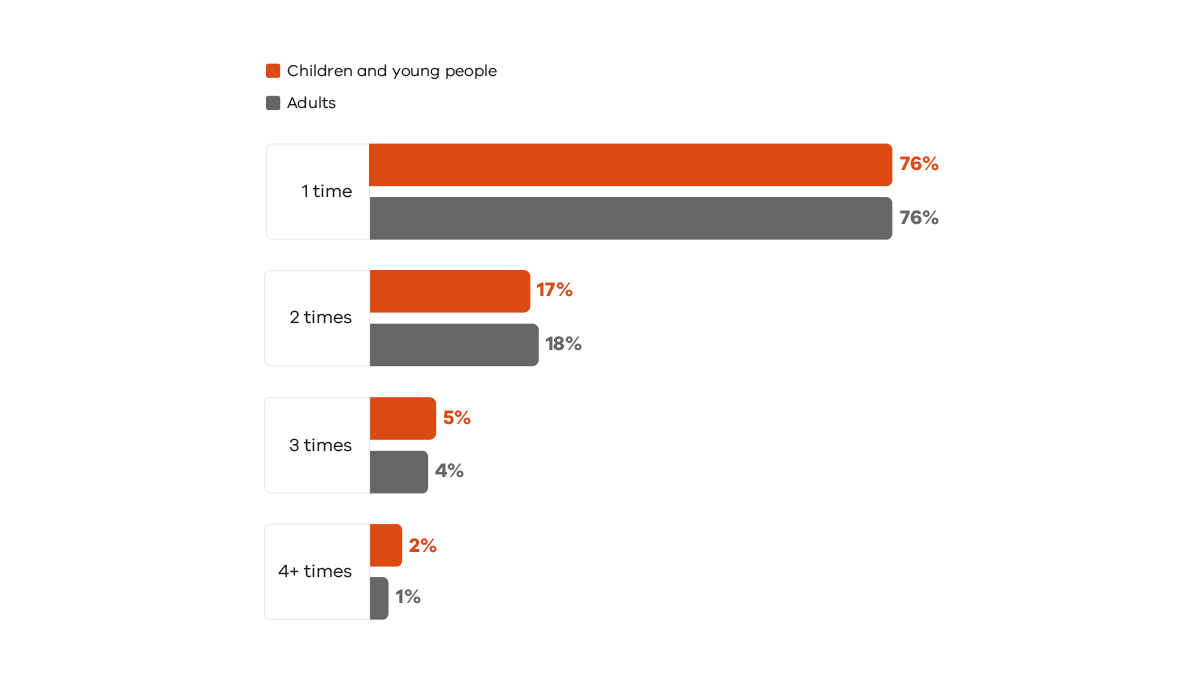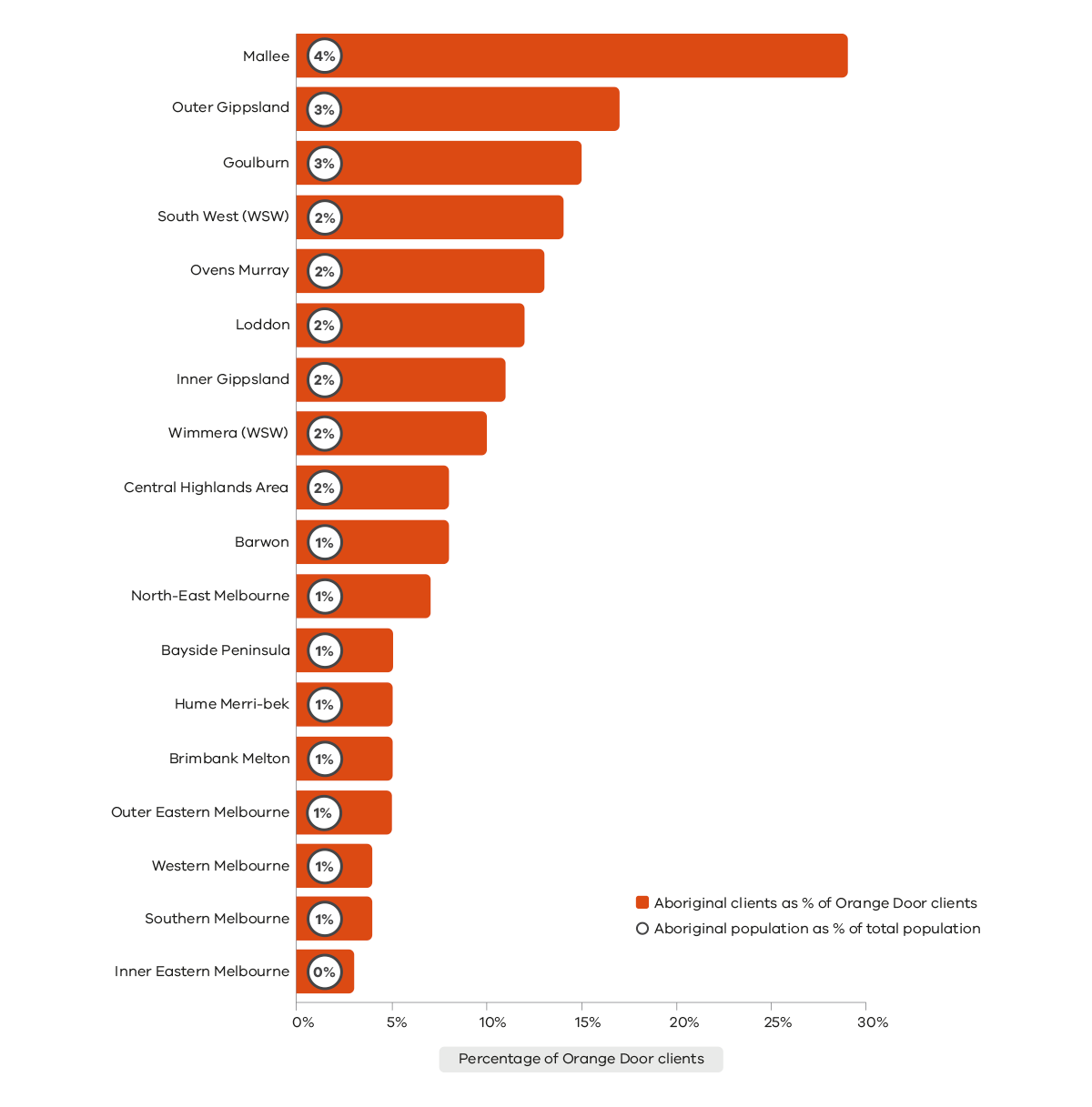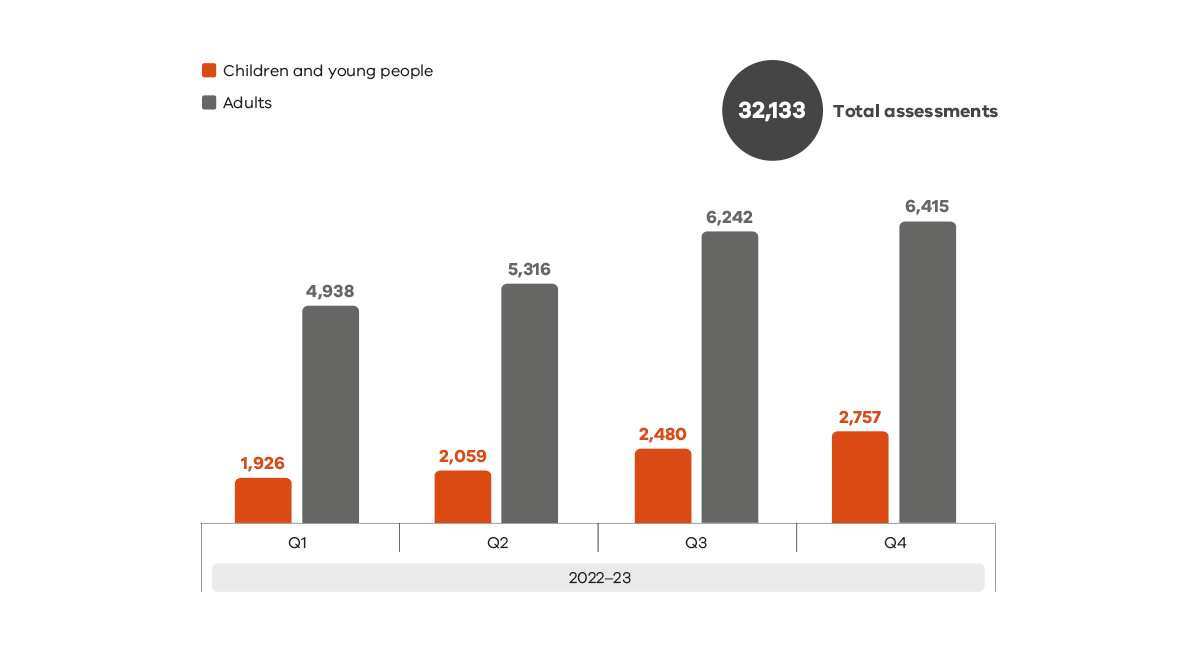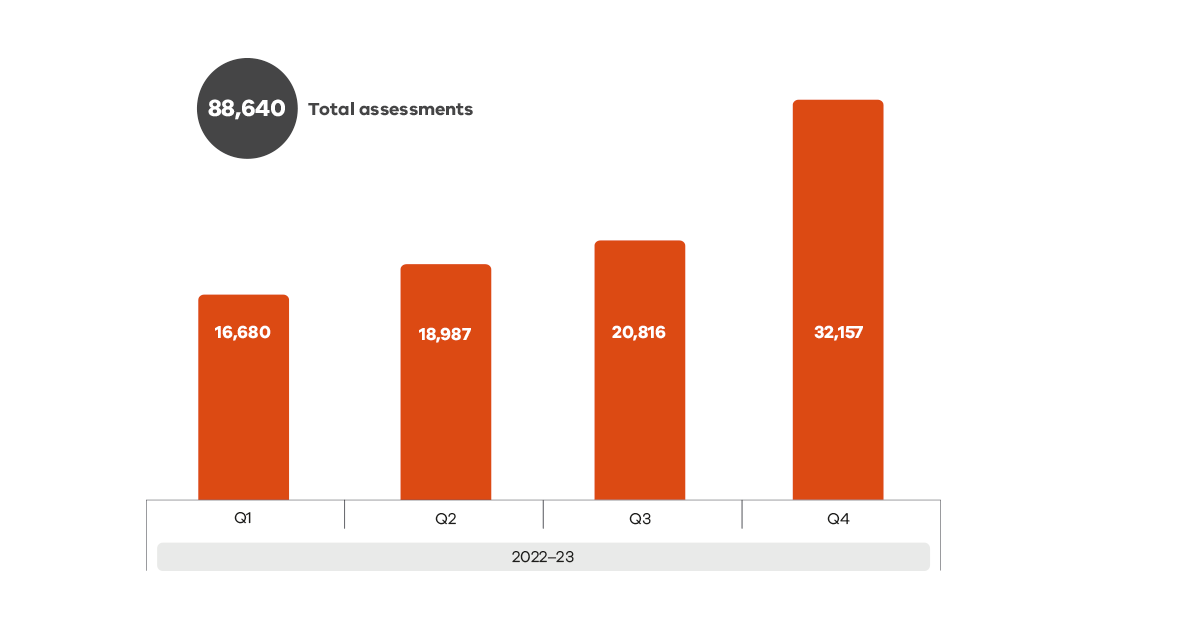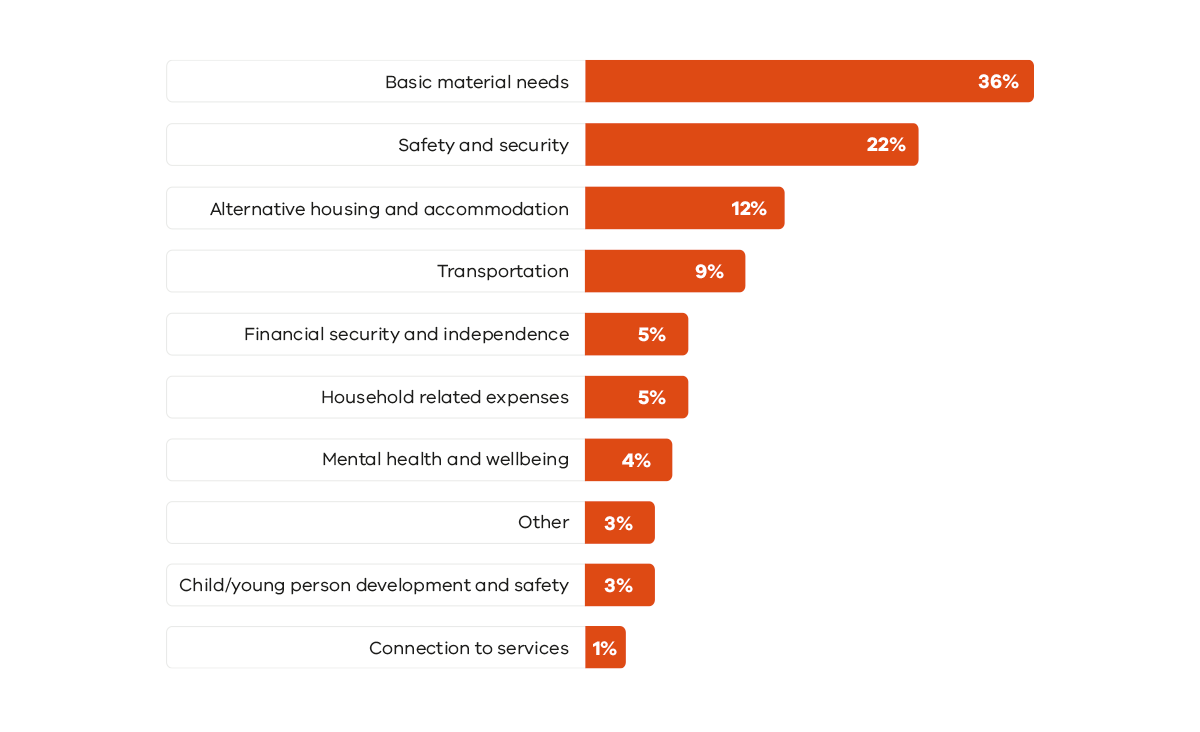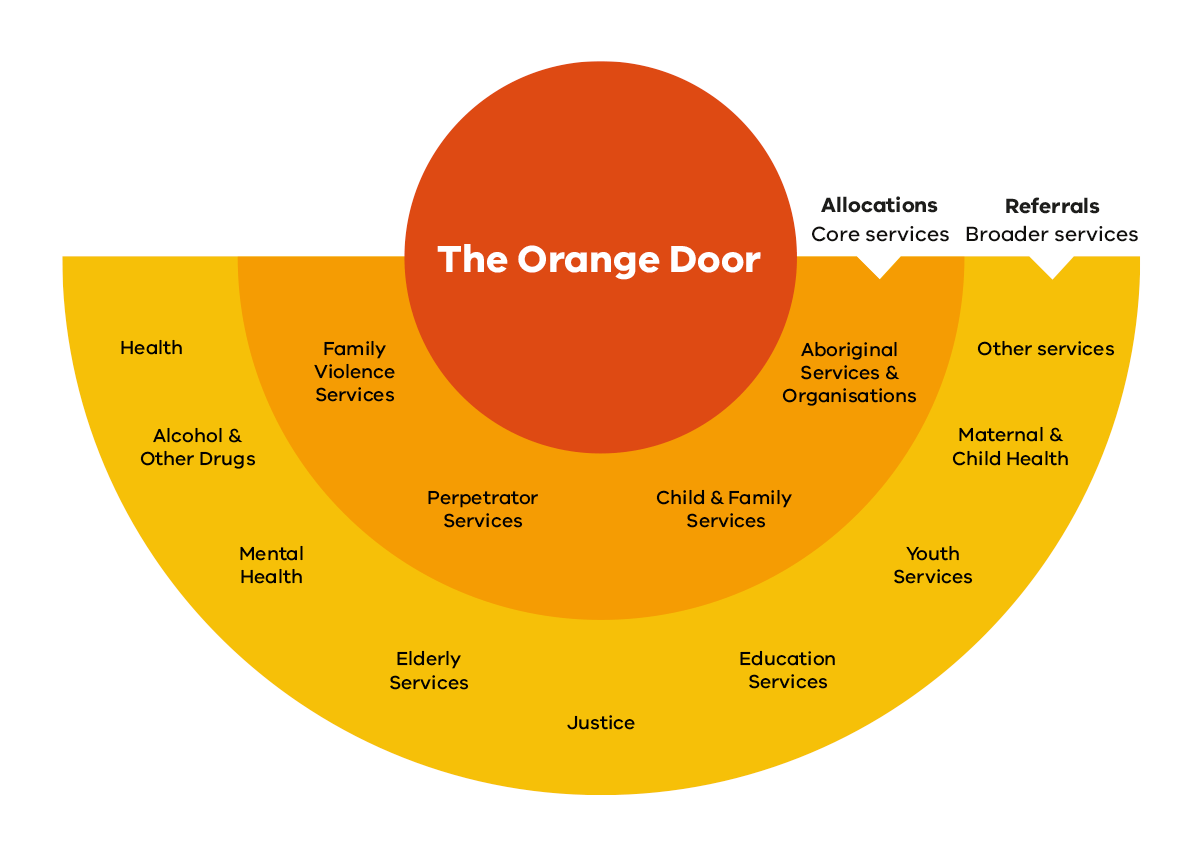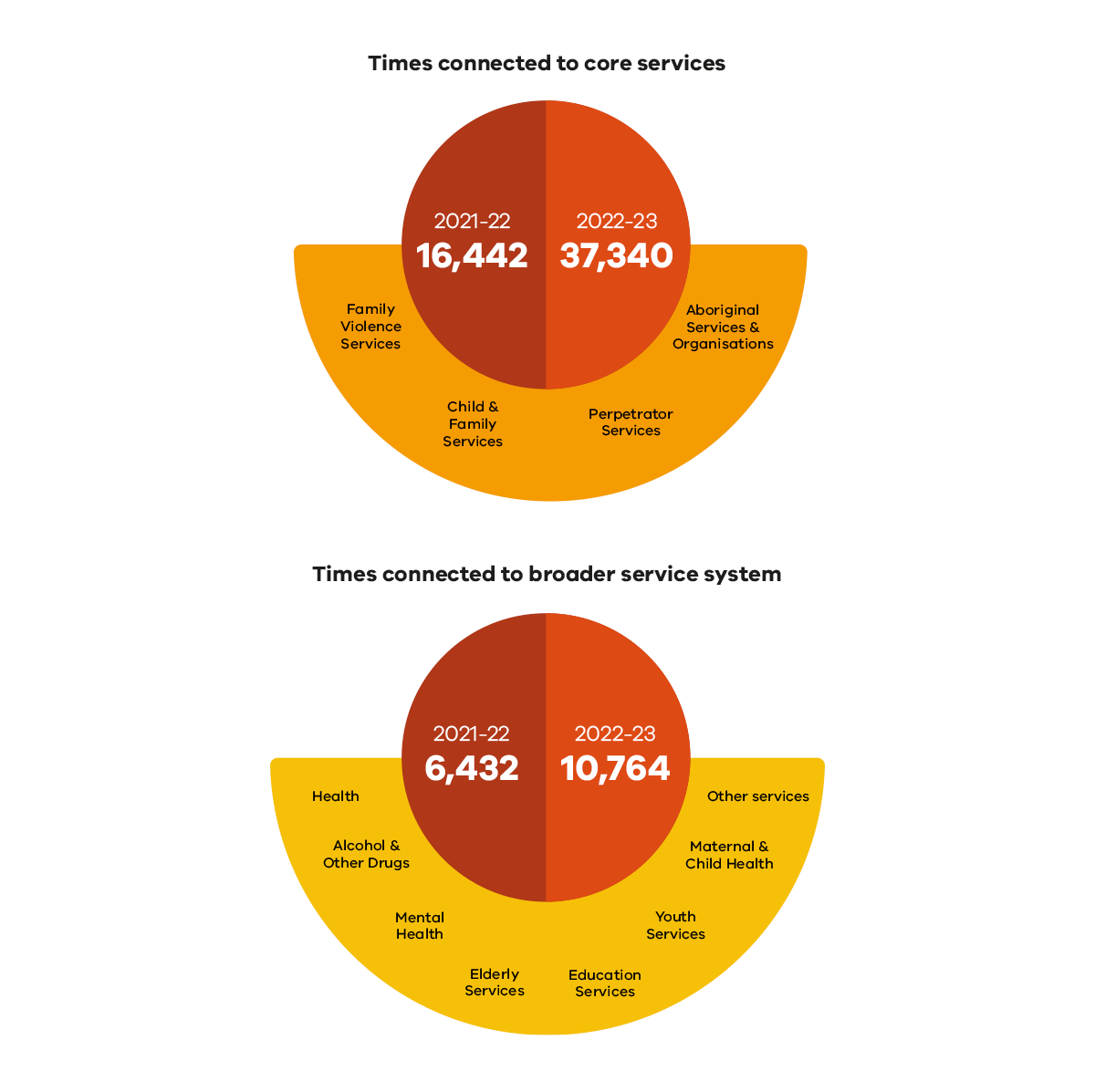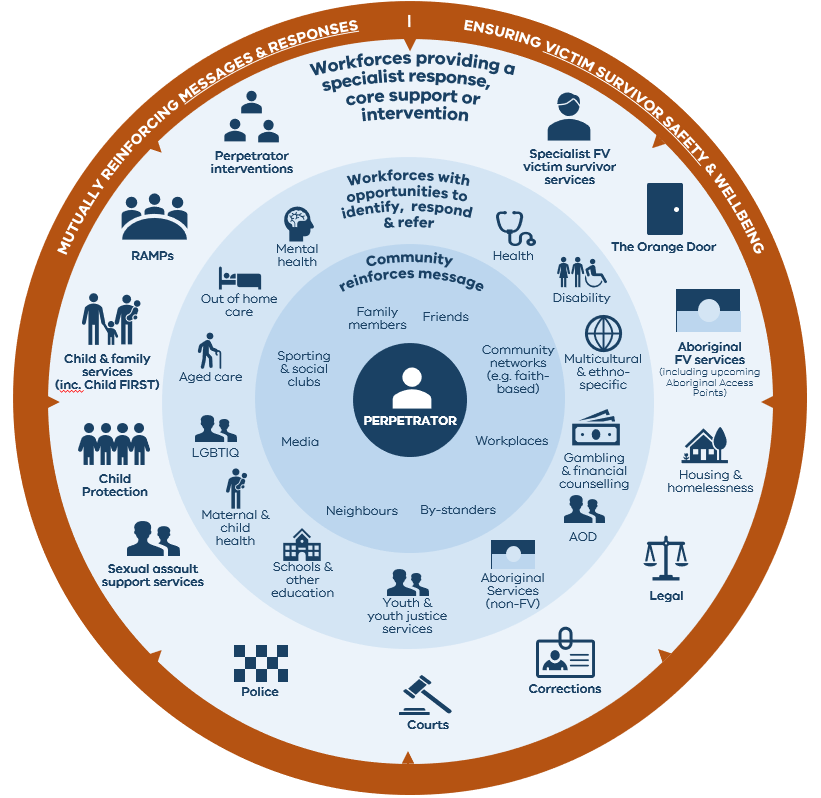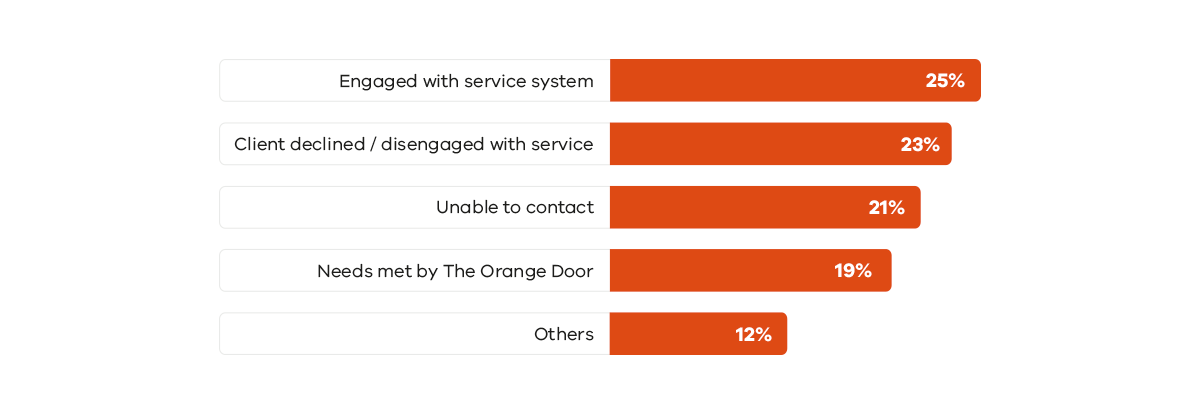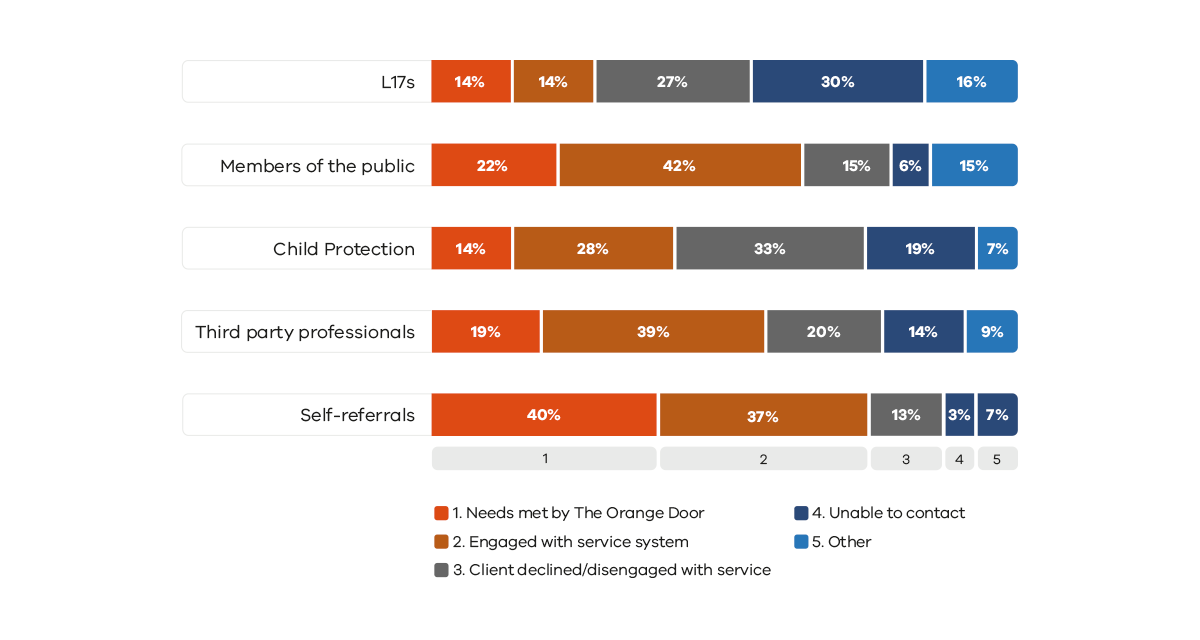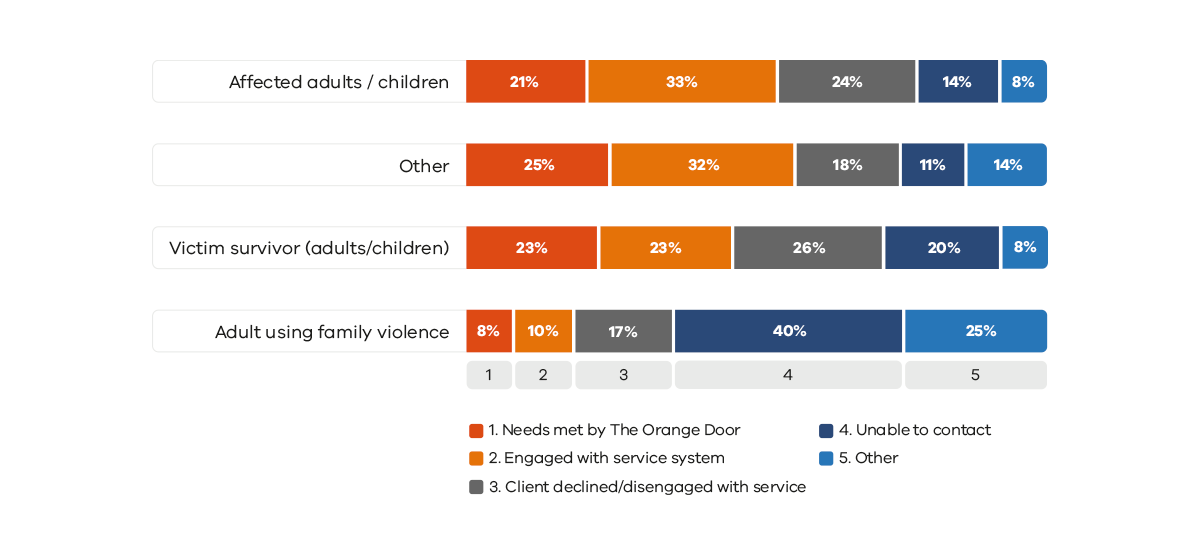- Date:
- 1 May 2024
To receive this document in another format, phone 03 9085 0900, using the National Relay Service 13 36 77 if required, or call the Department at 1300 475 170.
Aboriginal acknowledgment
The Orange Door Annual Service Delivery Report 2022-23.
The Victorian Government proudly acknowledges Victorian Aboriginal people as the First Peoples and Traditional Owners and custodians of the land and water on which we rely.
We acknowledge and respect that Aboriginal communities are steeped in traditions and customs built on an incredibly disciplined social and cultural order. This social and cultural order has sustained up to 60,000 years of existence.
We acknowledge the ongoing leadership role of the Aboriginal community in addressing and preventing family violence and join with our First Peoples to eliminate family violence from all communities.
Foreword
The Orange Door Annual Service Delivery Report 2022-23.
The Orange Door network has delivered ground-breaking family violence system reform. It operates as one of a kind in Australia.
The commencement of all The Orange Door areas represents a milestone in our efforts to address the issue of family violence for all victim survivors and improve the wellbeing of children and young people through the delivery of critical services to clients and families needing support across the state.
The Victorian government has led with an unprecedented commitment to tackle family violence, investing more than $3.86 billion since 2016.
The first Orange Door was established in Bayside Peninsula May 2018. Within four years, all eighteen locations were operational throughout metropolitan and regional Victoria.
The network has supported more than 368,000 Victorians, including 149,000 children. As an integrated system, The Orange Door operates with the support of community leaders, advocates and partner agencies. As a service system, it represents our determination to respond consistently to family violence and to child wellbeing across our state.
In January 2023, the Victorian Government announced that all recommendations of the 2016 Royal Commission into Family Violence had been implemented.
This track record of commitment, reform and investment also serves as recognition in Victoria that our work is not yet done. Intimate partner violence is perpetrated at high rates with devastating and at times tragic consequences. Victorian women are victims of family violence related murder, occurring at more than one death a week nationwide. Family violence remains the greatest contributor to early death, disability and illness in women aged between 15 and 44 years. Children and young people continue to suffer at unacceptably high rates, as illustrated by the Australian Child Maltreatment Study that found two thirds of Australians have been abused, neglected or exposed to domestic and family violence as children.
However, unlike many other jurisdictions, and after eight years of family violence reform, we now find ourselves in Victoria at a point of reflection following the publication of Strong Foundations: Building on Victoria’s work to end Family Violence and other rolling action plans.
We must now measure progress against service access, service inclusion and consistent standards of service delivery particularly in relation to risk assessment, risk management and safety. Self-determined responses to family violence must continue to be a statewide priority.
We are committed to public reporting of these outcomes. Shared information, data and reviews are opportunities for all of us to reflect on this unique era of advancing Victoria’s reform agenda. It is an opportunity to identify what more needs to be done, drawing on the determination that has brought us this far. This is how we will continue to review the unique operation of the Orange Door network in Victoria and the reform of the family violence service system across the state.
Dr Melanie Heenan
Deputy Secretary
Language in this report
The Orange Door Annual Service Delivery Report 2022-23.
Family violence includes:
- physical, sexual, emotional, psychological and economic abuse, as well as coercion and control, or
- domination that causes the family member to feel fear for the safety (or wellbeing) of themselves (or another) person the exposure of these behaviours (or the effects) upon a child.
There are many relationships in which family violence can occur. These include between:
- spouses or domestic /adult intimate partners
- other intimate personal relationships, such as parent to child, child to parent
- relationships with elders, siblings and other relatives
- between extended families, kinship networks
- in family-like or carer relationships.
Nonetheless, while the causes of family violence are complex, they are fundamentally shaped by gender inequality and community attitudes towards gendered roles in society.
Throughout this report references are made to adults using family violence (or persons using family violence where we have included young people using violence). Many communities prefer this to the term perpetrator and it is in common use in different practice settings. Where the term perpetrator is used, it does not label individuals or characterise their actions.
The phrase children and young people includes infants, where there is significant effort to ensure strong client (and family) outcomes. We acknowledge that young people who use violence in the home require separate, developmentally appropriate responses.
A client can be a child, young person or adult who accesses services from The Orange Door. Where there is a connection between individuals they are classified as a family and/or connected group. The word family itself has many different meanings. In this report, we acknowledge that a variety of relationships and structures can make up a family unit, and the range of ways family violence can be experienced, including through family-like or carer relationships.
Throughout this report, the term Aboriginal is used to refer to both Aboriginal and Torres Strait Islander peoples.
Diversity within the Victorian population is increasing as people express multiple forms of identity and belonging. Diverse groups can experience additional risk of family violence and particular barriers to seeking safety and justice.
Intersectionality describes how characteristics such as gender, ethnicity, ability, sexual orientation, gender identity, religion or age can interact on multiple levels to create overlapping forms of discrimination and power imbalances which compound the risk of experiencing family violence.
The service delivery report contains descriptions of family violence including physical and sexual violence as well as coercive and controlling behaviours.
Safe Steps can provide support via their phone line (1800 015 188) or email safesteps@safesteps.org.au.
If you are concerned about your own or someone else’s behaviour, call Men's Referral Service (1300 766 491), MensLine Australia (1300 789 978) or Rainbow Door (1800 729 367).
For localised support, you can find your local The Orange Door via The Orange Door Service Finder website.
Introduction
The Orange Door Annual Service Delivery Report 2022-23.
A flagship recommendation from the Royal Commission into Family Violence was to establish a network of Support and Safety Hubs across Victoria.[1] This is now known as The Orange Door network.
The Orange Door network is an integral part of Victoria’s family violence and family service system. It is a free, accessible assessment and brief intervention service for children, young people and adults who are experiencing or using family violence, and for families who need supports for the care and wellbeing of children and young people.
The Orange Door aims to ensure there is no wrong door to accessing high quality, consistent and effective support. People do not need a professional referral to access these services. No matter where you live in the state you can access support through The Orange Door. Family Safety Victoria (FSV) has worked in close partnership with partner agencies and other stakeholders to establish the governance, workforce and operational arrangements to ensure the state-wide service model is tailored to each local area.[2]
The significant work undertaken across government and the community sector to build and connect safe services and networks has been central to the successful implementation of The Orange Door. Since it commenced in May 2018, The Orange Door has supported more than 368,000 people, including more than 149,000 children.
The Orange Door Annual Service Delivery report 2022-23 represents the first financial year where all The Orange Door areas have been in operation with Wimmera (WSW) commencing in September, and the two final areas Brimbank Melton and Western Melbourne commencing in October 2022, as illustrated in Figure 1.
You can find locations and local contact information on the dedicated website. There are 18 primary areas supported by a growing number of access points, including dedicated Aboriginal access points.[3] Primary locations of The Orange Door network are illustrated below in Figure 2.
There continues to be an enormous commitment and effort by The Orange Door network workforce and partner agencies to deliver Victoria’s family violence and family services response. Operations are continually evolving, informed by the evidence about what works.
Notes
[1] Royal Commission into Family Violence recommendations website, State Government of Victoria, accessed 22 December 2023.
[2] Family Safety Victoria website, State Government of Victoria, accessed 22 December 2023.
[3] The Orange Door network, Contact Us webpage, State Government of Victoria, accessed 22 December 2023.
Data considerations
The Orange Door Annual Service Delivery Report 2022-23.
Sharing experiences and data from the fifth year of service delivery
This report uses service provision data to explain how The Orange Door network supported people in the 2022-23 financial year. Information and data has been collected from the Client Relationship Management (CRM) system and other integrated systems used by the staff in The Orange Door network.
This system continues to be enhanced to support best practice and gathers data to inform improvements to service delivery and policy. CRM updates for the 2022-23 financial year were the result of collaboration across multiple FSV teams and aligned to the release of operational guidance.
Significant enhancements included:
- continued auto population of data across CRM to reduce the administrative burden for The Orange Door staff
- further replacement of unstructured with structured data items and mandatory fields to support consistent data entry and reporting, including for priority communities
- introduction of an interactive single screen for each person showing their demographic information and a summary of their engagement with The Orange Door
- ability to record multiple brokerage items and brokerage crisis accommodation in the CRM to (support and oversight and monitoring)
- improvements to actions taken in service plans and alerts, including the creation of an alert management plan.
As data collection through statewide operational guidance and reporting processes and practice continue to be strengthened, our ability to comment on the experiences of those accessing the network and their service needs will improve.
Presentation of the data
In many cases, the data is broken down by quarters:
- Quarter 1 (July – September 2022)
- Quarter 2 (October – December 2022)
- Quarter 3 (January – March 2023)
- Quarter 4 (April – June 2023).
Throughout the report these are referred to as Q1, Q2, Q3 and Q4. Data extracted from the CRM for this report was extracted in November 2023, which ensures most of the information from 2022-23 is finalised.
In some instances, this report provides comparisons between data from 2018-19, 2019-20, 2020-21, 2021-22 and 2022-23.
Inherent limitations
Because data in the CRM is constantly updated, including in relation to cases from previous years, figures in this report may be slightly different compared to previous reports.
Due to the staggered nature of the commencement of The Orange Door areas, the opening of new sites results in additional capacity across the network, thereby contributing to growth in overall service delivery. This is particularly noticeable when comparing to a previous period when fewer sites were in operation.
About The Orange Door
The Orange Door Annual Service Delivery Report 2022-23.
What is The Orange Door network and how does it work?
The Orange Door network is for children, young people and adults who are experiencing or using family violence, and for families who require support with the development and wellbeing needs of their children and young people.
It assesses and responds to a person’s needs and risk, and connects people to family violence services, local Aboriginal services, family services and services for adults using family violence. Together these are referred to as ‘core services’.[1]
The Orange Door seeks to engage with adults using family violence to support them in getting the assistance they need to address their violent behaviour. In addition they work with the wider system to keep the person’s use of violence in view and minimise the risk they pose to others.
The Orange Door keeps the whole family in view and provides a more visible contact point to access for people who are experiencing or using family violence, as well as families needing support with the wellbeing and development of children and young people, with support tailored to each family member’s needs.
The Orange Door network also connects people to a broad range of services such as mental health, disability services or housing support. Practitioners support people to navigate the service system and address the spectrum of needs that might be identified.
How The Orange Door network is set up to support people
The Orange Door functions include:
- initial contact and advice
- triage
- crisis response
- Family violence risk assessment
- Child wellbeing assessment
- safety planning
- service planning and referrals
- secondary consultation and capacity building.
The Orange Door brings together family violence, family services and Aboriginal Community Controlled Organisations (ACCOs) as interdisciplinary teams to provide an integrated intake point in each area. The client’s risk and needs are centred in the Integrated practice response.
The Orange Door network facilitates strong connections into local community services to support clients to get the help they need from other services. This includes working in partnership with local ACCOs and communities to support Aboriginal self-determination and ensure that culturally safe responses are available for Aboriginal people.
The Orange Door network is comprised of a primary site, access points and outposts across an area to maximise the opportunities for people to get help they need close to home. Individuals and families who need support can make direct contact themselves via phone, email or by attending The Orange Door.
Access planning to increase the number of walk-in and appointment-based locations is underway across the state. The Orange Door network walk-in services are in Bacchus Marsh, Bairnsdale, Ballarat, Bendigo, Box Hill, Broadmeadows, Colac, Cranbourne, Croydon, Dandenong, Echuca, Epping, Frankston, Geelong, Hastings, Heidelberg, Horsham, Leongatha, Maryborough, Melton, Mildura, Morwell, Pakenham, Sale, Shepparton, Sunbury, Swan Hill, Wallan, Wangaratta, Warragul, Warrnambool, Werribee and Wodonga.
Led by the Aboriginal Initiatives Unit, the Aboriginal Access Point Service Model endorsed by the Dhelk Dja Koori Caucus in May 2021 is being implemented through three Aboriginal access points. Delivered by local ACCOs and staffed by an Aboriginal workforce, access point services support access to culturally safe information, planning, referral and exit pathways and holistic healing responses to family violence for Aboriginal families.
They are complemented by the service offerings of The Orange Door network and work closely with The Orange Door Aboriginal Practice Leaders to ensure appropriate referrals for clients to relevant services.
Who works at The Orange Door network?
The Orange Door workforce is comprised of interdisciplinary teams involving specialist staff from across community services, health services and ACCOs. In addition, the Community Based Child Protection team is part of The Orange Door workforce, in conjunction with a team of staff employed by FSV.
The workforce includes:
- Specialist Practitioners: The expertise of different practitioners is drawn upon to provide an interdisciplinary approach with specialists in family violence, child and family services, ACCOs and perpetrator services working together in The Orange Door network.
- Practice leadership: Practice leadership is provided to practitioners to support high quality and culturally safe service delivery through roles such as: Team Leader, Aboriginal Practice Leader, Advanced Family Violence Practice Leader, Integrated Practice Leader, Cultural Safety Project Leaders, Children and Young People’s Practice Leader, Advanced Family Violence (PUV) Practice Leader and Community Based Senior Child Protection Practitioners.
- Operational support: The Orange Door network teams are supported by a team from FSV that includes a Manager, Service System Navigator, Strategic Planning and Reporting Officer, Operational Support Officers, Client Support Officers and administrative support staff.
The total funded workforce for the eighteen The Orange Door areas operational at 30 June 2023 was just over 1,400 Full Time Equivalent (FTE) positions comprising a range of different roles (Figure 3). Of those, 218 FTE positions were vacant at that point in time.
The Orange Door staffing profile faces similar significant workforce shortages as the broader community services workforce. Addressing these shortfalls, the Family Violence and Sexual Assault Graduate Program attracted over 100 high-quality graduates between 2021 and 2023.
These programs complement the implementation of numerous capacity development initiatives for frontline workers across the service system, including the commencement of Aboriginal cultural safety training to all staff, and delivery of the Induction program, which includes strengthening of the skilled practice of staff in working with Culturally and Linguistically Diverse communities.
FSV continues to work collaboratively with peak bodies and service partners to strengthen workforce capability in culturally responsive, skilled and integrated practice, for instance, with the Rainbow Health LGBTIQA+ program which is due to commence in Hume Merri-bek and Central Highlands in the coming year.
Working with Clients in The Orange Door integrated training is delivered to all practitioners by the Peaks Partnership (No to Violence, Safe and Equal and the Centre for Excellence in Child and Family Welfare) and adopts a skills-based training approach.
Notes
[1] The Orange Door network provides a range of responses to individuals and families referred through for support, from the assessment of risk and need, development of safety plans, provision of an immediate crisis response, access to brokerage and connection to other services for ongoing support such as family violence case management and family services. The Orange Door network, What is the Orange Door webpage, State Government of Victoria, accessed 7 November 2022.
Referrals and access
The Orange Door Annual Service Delivery Report 2022-23.
How are people accessing The Orange Door network for assistance?
The Orange Door network aims to be accessible, safe, and welcoming to people, providing quick and simple access to support. Referrals to The Orange Door network have increased significantly since the state-wide rollout commenced in May 2018 having received over 425,000 referrals for individuals and families since then.
Referrals to The Orange Door network come from a range of sources including:
- L17 police referral reports
- direct contact (or ‘self-referral’)
- Child Protection
- other professional sources
- members of the public.
In 2022-23, The Orange Door network received almost 158,000 referrals alone. Almost half of the referrals received included at least one child. This represented a 48.8% increase in referrals since 2021-22, with the increase largely due to the continued expansion of The Orange Door network.
Since statewide rollout, the pattern in family violence referrals shows a consistent annual seasonal cycle. This is heavily influenced by L17 police referral reports (also known as L17s) where reporting peaks in summer and troughs in winter (Figure 4). The statewide pattern is also influenced by Child Protection referrals that routinely show a drop during school holidays – particularly over the summer period, noting that teachers are a major referral source to Child Protection and are unable to refer during school holidays.
In 2022-23 the most common way people accessed The Orange Door network was through L17 police referral reports which made up 55.4% of all referrals (Figure 5).[1] This represents a slight decrease from the previous year, and a more pronounced decrease from 2018-19 when L17 police referral reports were 63.9% of all referrals.
People do not need a formal referral to access The Orange Door network. Individuals and families who need support can make direct contact themselves, which is called a ‘self-referral’. These self-referrals include contact via phone, email or by physically attending The Orange Door.
Self-referrals have progressively increased since the commencement of The Orange Door network. In 2022-23, self-referrals comprised 22.4% of all referrals, up from 19.7% in 2021-22 and 17.2% in 2020-21. This may reflect the establishment of more visible and accessible entry points, as well as clients feeling more comfortable with reaching out to the Orange Door.
How does the community presence of The Orange Door network support safe and easy access?
The Orange Door network is designed to be a safe and accessible community service to make it easier for people seeking help for family violence or help with the wellbeing of children, young people and their families. People can contact The Orange Door in ways that are convenient, safe and accessible for them, including by telephone, email and in person. Each area has a toll-free telephone number and a direct email address to facilitate ease of contact.
People who make direct contact with The Orange Door through self-referral generally do so by telephone (81.2%), as do people making contact on behalf of someone they know (77.3%). Referrals received from professionals (excluding L17 police referral reports) are mostly received by email (88.4%) or telephone (11%). Across all types excluding L17 police referral reports, 47.6% of all referrals are received by email (Figure 6). L17 police referral reports are received via a dedicated system, and the large majority of Child Protection referrals are received via email.
Finding a local Orange Door
The Orange Door provides an entry point for family violence and family services that aims to ensure there is no wrong door to access high quality, consistent and effective support for children, young people and adults in communities.
The Orange Door network website[2] has a service finder function to support people to find the contact details for The Orange Door network in their area. Information contained on The Orange Door website is accessible in 50 different languages.
In 2022-23, the website was visited over 447,000 times by over 267,000 people. This represented a 27% increase in visits and a 22% increase in users compared to 2021-22. In 2022-23, the Caring for Children page had a 73% increase in page views.[3]
Notes
[1] Referrals that come directly from Victoria Police when there has been a report of an incident of family violence (known as ‘L17s’) are provided through a dedicated online portal (the L17 portal).
[2] The Orange Door network, Contact Us webpage, State Government of Victoria, accessed 7 November 2022.
[3] This data was sourced from the Single Digital Presence Dashboard, State Government of Victoria, accessed 21 November 2023.
People provided with a response
The Orange Door Annual Service Delivery Report 2022-23.
Who is accessing The Orange Door network for assistance?
The Orange Door network aims to be responsive and accessible for all, and inclusive of individuals of all ages, genders, abilities, sexes, sexual orientations, cultures and religions.
The Orange Door network recognises that people can face additional barriers to getting the help they need, due to systemic or structural discrimination. The establishment and operations for The Orange Door network is informed by Everybody Matters: Inclusion and Equity Statement (Everybody Matters), first published in April 2019.
Everybody Matters represents a 10-year commitment to building an inclusive, safe, responsive and accountable family violence system for all Victorians. The statement calls out the need to address barriers that people from a diverse range of communities face, when reporting family violence and when seeking or obtaining help.[1]
The Orange Door Inclusion Action Plan was subsequently released in 2021 and seeks to enhance inclusion, access, and equity across The Orange Door network. The Plan was developed with partner agencies and sets out how The Orange Door network will ensure services are accessible for all clients, and offer supports tailored to individual needs and experiences. The Plan outlines actions aimed at achieving inclusion, including through the physical environment, leadership, communication, training and connection with local communities.
With state-wide establishment of The Orange Door network, ongoing implementation of the Plan will continue to support The Orange Door network in responding to Victorian communities and meeting their diverse cultural and social needs.
How many people has The Orange Door network sought to support?
Noting that a single referral may involve numerous individuals (such as members of a family), in 2022-23 almost 191,000 people including over 82,000 children and young people (including unborn children) were referred to The Orange Door network and provided with a response.[2]
Children and young people represented 43.1% of all people provided with a response in 2022-23. Compared to 2021-22, this represented a 48.7% increase in the total number of people and a 53.5% increase in the number of children and young people provided with a response. This is consistent with the growth in referrals to The Orange Door and can be attributed to the continued expansion of the network over the period.
Individuals and families can seek assistance from The Orange Door network as many times as they need. In 2022-23, 23.7% of people who received a response from The Orange Door were referred or sought assistance two or more times during the financial year. Children, young people and adults displayed a similar pattern in the number of times they were referred or sought support from The Orange Door network (Figure 7).
Working with people from diverse communities
The Orange Door network seeks to welcome people of any age, gender, ability, sex, sexuality, ethnicity, culture or religion. The Orange Door network aims to provide people from diverse communities a safe service response where their cultural and religious and other preferences and specific needs are respected.
In 2022-23, almost three in five adults (58.3%) who were provided a response from The Orange Door identified as female, compared to 40.7% who identified as male and 0.1% who self-described their gender identity. For children and young people, 48.4% identified as male, 46.4% identified as female and 0.3% self-described their gender identity.
The Orange Door CRM has been enhanced to collect better and more nuanced information about a range of identifiers. Future enhancements are planned to align the CRM with revised LGBTIQA+ data collection standards. Although data quality around client identity is constantly improving, identifiers for Culturally and Linguistically Diverse, LGBTIQA+ and disability status are not yet reliable enough to report.
Orange Door multicultural advisory groups have been established in areas which have a high number of multicultural residents, including Southern Melbourne, Bayside Peninsula, Hume Merri-bek, Barwon and North East Melbourne. These meet bi-monthly to ensure services meet the needs of multicultural communities.
The Service System Navigators who work for The Orange Door participate in existing multicultural networks. Where needed, arrangements are in place with partner agencies in that area to support client referrals to The Orange Door.
Other initiatives have focused on:
- the strengthening of service systems to better respond to children, young people and adults with disabilities at risk of family violence
- the strengthening of linkages and referral pathways with disability and other community-based services in local areas
- the provision of an LGBTIQA+ module as required training for all staff commencing at The Orange Door
- and The Orange Door statewide Inclusion Action Plan refresh.
Supporting Aboriginal self-determination
Aboriginal Community Controlled Organisations (ACCOs) are critical partners in The Orange Door network. They receive funding to employ an Aboriginal Practice Leader and/or Aboriginal hub practitioners to ensure that Aboriginal people receive a culturally safe response. In addition, ACCOs support the establishment of the Aboriginal Advisory Group which involves community members, members of the local Dhelk Dja Action Group and other ACCOs to ensure a culturally safe response and strong connections with the local community.
An Aboriginal Inclusion Action Plan for The Orange Door network was developed in consultation with the Dhelk Dja Koori Caucus, Priority Sub-Working Groups and Aboriginal Advisory Groups and endorsed by the Dhelk Dja Partnership Forum in May 2021. The Aboriginal Inclusion Action Plan is aligned to Dhelk Dja Agreement: Safe Our Way – Strong Culture, Strong Peoples and Strong Families and underpinned by the principles in the Ngarneit Birrang Holistic Healing Framework.[3]
To support the Aboriginal Inclusion Action Plan, the Strengthening Cultural Safety Training Program was delivered across The Orange Door network, building on existing partnerships with local ACCOs. The program aims to support a culturally safe environment for Aboriginal people seeking a service, as well as the Aboriginal workforce through sustainable, locally driven implementation. The program includes employment of Cultural Safety Project Leaders to facilitate cultural safety self-assessments and provide foundational training to staff.
To expand accessibility for Aboriginal people, Aboriginal access point services have been established in Bayside Peninsula, supporting Aboriginal children, young people, adults and families to navigate the family violence service system. A second site is to be established in Barwon later in 2023 and a third site in the Mallee area is expected to commence in 2024.
Aboriginal people are significantly impacted and over-represented among The Orange Door network’s client base, with the National Plan to Reduce Violence against Women and their Children highlighting Aboriginal women were 35 times more likely to experience family violence than non-Indigenous Australian women.[4]
This highlights the strong need for culturally safe and appropriate responses tailored for this community. In 2022-23, over 14,000 people provided with a response from The Orange Door identified as Aboriginal. Of these, 49.7% were adults and 50.4% were children or young people (including unborn children). This represented 7.5% of all people provided with a response from The Orange Door in 2022-23, dropping from 9.0% in 2021-22. The decrease is likely due to lower proportions of people identifying as Aboriginal in more recently opened The Orange Door areas in 2022-23.
Across Orange Door areas in 2022-23, the proportion of Aboriginal clients varied with a greater proportion of services delivered to Aboriginal clients in regional areas, ranging from 29.3% in Mallee to 3.4% in Inner Eastern Melbourne (Figure 8).[5] This can be partly explained by variation in population size, with Aboriginal people representing approximately 4.1% of the broader population in the Mallee area but only 0.3% of the broader population in Inner Eastern Melbourne.
Dhelk Dja is the key Aboriginal-led Victorian agreement that commits signatories to work together and be accountable for ensuring that Aboriginal people, families, and communities are stronger, safer, thriving and living free from family violence. It articulates the long-term partnership and directions required at a state-wide, regional, and local level to ensure that Aboriginal people, families, and communities are violence free and that services are built upon the foundation of Aboriginal self-determination.
The second Dhelk Dja 3 Year Action Plan 2023-25 was developed with the Dhelk Dja Koori Caucus and endorsed in 2023, with regional action plans being developed to support its implementation. Each of the new actions recognise the need to invest in Aboriginal culture, leadership and decision-making as the key to ending family violence in Victorian Aboriginal communities.
Allira’s story: cultural safety in Aboriginal family violence response[6]
Allira is an Aboriginal woman who relocated from another state to Victoria with her partner Bertie and her three children. Bertie is non-Aboriginal and is not the biological father of the children. The family relocated to Victoria on Bertie’s insistence.
Allira was born on Country and English is her third language. Two of her children are hers biologically, and one is a cultural adoption which is a practice in line with customs and childrearing from that community.
The Orange Door received a third-party referral for Allira and her children due to Bertie’s use of family violence towards them. Allira provided consent for the referral, and a practitioner from The Orange Door’s Aboriginal Response Team made contact that day to begin risk assessment and safety planning.
The practitioner used a cultural lens to adapt how they engaged with Allira and her children. This included asking Allira for her wisdom in child-rearing and safety planning. The practitioner also spoke with Allira about how the exploration of her Country’s message had softened due to the family violence.[7]
The practitioner consulted with their Aboriginal Practice Leader who provided information about interstate Aboriginal Interpreter Services, advice on culturally appropriate language and ensured Allira was informed and empowered about the case direction through the presence of self-determination and self-agency.
The practitioner identified that Allira and her children’s ability to return to Country was the highest priority for the family’s safety and wellbeing, given their geographical isolation and the impact of missing Country.
In safety planning for the return trip, the practitioner focused on understanding whether Allira had support systems in community and used cultural concepts from Allira’s people to address questions about violence and trauma. This included asking questions such as, ‘Who is there in the community that you can quiet yarn with?’ and ‘As we believe in you, which aunties in community will you yarn to and who will believe in you?’
Allira provided consent for the practitioner to contact interstate family violence services and make referrals on her behalf. Allira’s case was closed after the family arrived and on confirmation that the relevant services had been in contact.
Notes
[1] The Orange Door Inclusion Action Plan is a two-year plan to embed inclusion, access, and equity in the services and policies of The Orange Door network. Developed in 2019-20 with partner agencies and released in 2021, it sets out how The Orange Door network will ensure services are accessible for all clients and offer supports tailored to individual needs and experiences. More information about the statement can be found at Everybody Matters: Inclusion and Equity Statement webpage, State Government of Victoria, accessed 13 October 2022.
[2] In instances where families are referred to The Orange Door network, practitioners consider the needs of each individual family member separately. Accordingly, the number of individuals The Orange Door network works with is greater than the number of referrals received.
[3] Dhelk Dja Agreement: Safe Our Way – Strong Culture, Strong Peoples and Strong Families webpage and Nargneit Birrang - Aboriginal holistic healing framework for family violence webpage, State Government of Victoria, accessed 13 October 2022.
[4] National Plan to reduce violence against women and their children, Department of Social Services, Australian Government, accessed 26 February 2024.
[5] Australian Bureau of Statistics 2021, Indigenous Status (INGP) by Victorian Local Government AREA, [Census TableBuilder], accessed 13 October 2022.
[6] Names and identifying features of the people involved in this case study have been changed.
[7] Allira’s people believe that voice of the ancestors are always present, and that her people’s message remains with you even when one leaves Country.
Identifying risk and needs
The Orange Door Annual Service Delivery Report 2022-23.
How is The Orange Door network working with people to identify risk and prioritise their needs?
Practitioners at The Orange Door network are supported to do their work by:
- changes to information sharing legislation
- an improved family violence risk assessment and management framework
- the Central Information Point (CIP)
- assessments aligned to the Best Interest Case Practice Model
- working within interdisciplinary teams.
The Orange Door network takes a person-centred approach to working with clients by identifying service responses based on risk and need including family violence, and safety and support of children and young people. Children and young people are treated as individual clients in their own right, where their wellbeing and/or experience of family violence are assessed and responses and provided.
Once a referral is received, priority and urgency is determined through the screening, identification and triage process. An initial assessment is undertaken based on information in the referral, the referral history at The Orange Door, and any past engagement with partner agencies.
The referral will then move on to the assessment and planning stage, where practitioners engage with the individual/family to assess:
- key risks and wellbeing
- needs of each individual
- their goals and preferences in the context of their family and community
- safety planning (as required)
- connection to services.
The Orange Door network works with Risk Assessment and Management Panels (RAMPs) to ensure that high risk situations are managed in the best possible way.[1]
RAMPs are responsible for developing and implementing multi-agency action plans for individual high-risk cases. This lessens or prevents serious threats to children, young people and victim survivors and increases accountability of the person using family violence.
RAMPs receive referrals from services working with victim survivors or families, where there are concerns that there is a high risk of harm that is not adequately mitigated by the current range of interventions. 18 RAMPs currently operate across Victoria.
Assessing risk where family violence is present
Practitioners within The Orange Door network assess the family violence risk that adults using family violence pose for victim survivors. Practitioners work across specialisations to ensure there is an interdisciplinary response to addressing identified risk and needs and to develop appropriate risk management strategies, including safety planning. The process of assessing family violence risk is ongoing throughout the time that The Orange Door network works with a client.
The Family Violence Multi-Agency Risk Assessment and Management (MARAM) Framework supports professionals to effectively identify, assess and manage family violence risk. The MARAM Framework together with the Family Violence Information Sharing Scheme (FVISS) strengthens system-wide family violence risk assessment and management and facilitates better sharing of risk-relevant information between services. This helps keep people safe and persons using family violence in view.
In addition, the Child Information Sharing Scheme (CISS), supports professionals in sharing information to promote the safety and wellbeing of children and young people (child safety and wellbeing assessment is explored in a separate section below).
In 2022-23, practitioners undertook over 32,000 family violence risk assessments.[2] Of these, almost 23,000 assessments were undertaken for adult victim survivors and over 9,000 were undertaken for children and young people experiencing family violence (Figure 9).
The number of assessments undertaken by practitioners increased by 37.5% compared to 2021-22. While the increase in risk assessments is mostly due to the commencement of the three new The Orange Door areas in 2022-23, confidence in undertaking risk assessments and information sharing under MARAM continues to grow.
The number of risk assessments undertaken in 2022-23 was lower than the number of people who were provided with a response. This reflects the fact that The Orange Door network is sometimes unable to contact the person referred (21.3% in 2022-23), or when they do the person chooses not to take up the offer of a service or support (23% in 2022-23). These proportions include referrals for adults using family violence, noting that risk assessment for this group of clients was not yet available during this reporting period as the Adults Using Family Violence-focused comprehensive risk assessment tool was released in July 2023.
The practice of recording family violence risk assessments is improving across The Orange Door network. Nonetheless, it continues to be an area for further improvement and development.
Safety planning
For people experiencing family violence, safety planning is a key part of risk management that is undertaken by The Orange Door network as an immediate support intervention. It typically involves a plan developed by a practitioner with the victim survivor to help manage their own safety in the short to medium term.
In 2022-23, practitioners in The Orange Door network recorded over 21,000 safety plans in the CRM to help keep victims of family violence safe, a 33.4% increase from 2021-22.
Central Information Point
The CIP commenced in 2018 and is a unique initiative that helps to keep persons using family violence in view. The CIP consolidates critical information relevant to family violence risk from Victoria Police, Corrections Victoria, the Magistrates’ Court of Victoria, and the Department of Families, Fairness and Housing.
Information from these sources about a person using family violence or alleged person using family violence is consolidated into a single report for The Orange Door network practitioners to assist with family violence risk assessment and management. In 2022-23, over 4,800 CIP reports were provided to practitioners in The Orange Door network.
In addition to The Orange Door network, the CIP is available to RAMPs, who facilitate meetings to support the safety of victim survivors experiencing serious risk of family violence. The CIP also commenced service delivery to Men’s Referral Service and Safe Steps in November 2022, in line with the Royal Commission’s recommendations.
Jonathan and Suzie's story – assessing risk and safety based on the CIP report[3]
Jonathan is a 25 year old man referred to The Orange Door after police attended a family violence incident involving him and his girlfriend Suzie. Neighbours contacted the police when Jonathan physically threatened Suzie with a knife. Police removed Jonathan and remanded him in custody.
When The Orange Door received the police referral, Jonathan and Suzie were assigned different practitioners who worked together in the same integrated team. Throughout The Orange Door involvement, the two practitioners provided an integrated response by sharing risk information they had gathered with each other. The practitioners also consulted with Practice Leadership to support their assessments and decision making.
When The Orange Door received the L17 police referral, the practitioner reviewed Jonathan’s history and found an extensive history of family violence. Based on this history, the practitioner requested a CIP report on Jonathan’s use of violence towards Suzie. The CIP report includes information that Jonathan has been assessed as having an intellectual disability and suffering depression. The CIP report included a summary of Jonathan’s family violence offences towards Suzie including the use of force, carrying weapons, arson related offences, self-injury and sexual offences. The CIP report also highlighted that Jonathan is engaged with a corrections worker for the next year.
Based on the CIP report the practitioner worked with Jonathan and proactively contacted his corrections worker to discuss the L17 police referral. Jonathan’s corrections worker informed the practitioner that Jonathan is well-engaged and also has access to services including a psychologist and NDIS practitioner. The corrections worker stated that he would reach out to Jonathan in custody to coordinate his support while in remand.
The Orange Door practitioner, now knowing the extent of Jonathan’s intellectual disability, provided a secondary consultation on behaviour change interventions for Jonathan’s use of violence and discussed the option of a Men’s Behaviour Change (MBC) program specifically designed for men with an intellectual disability.
The Orange Door practitioner also collaborated with Victoria Police as Jonathan had been assigned to the Family Violence Investigation Unit due to his level of risk. The Orange Door practitioner shared the risk information from the CIP report with Victoria Police, including their assessment of the serious risk of violence towards Suzie.
The other practitioner in the same Orange Door contacted Suzie who is currently homeless and has made a police statement in relation to the sexual violence. Suzie agreed to develop a safety plan for when Jonathan is released from custody.
The two practitioners coordinated an integrated response, in consultation with Practice Leadership that prioritised the safety of Suzie, as well as addressing the risks and treatment needs of Jonathan.
Based on the information contained in the CIP report, the practitioner organised for Suzie to be provided refuge accommodation, with the immediate goals of coordinating supports in relation to the sexual assault she experienced.
Jonathan agreed to engage with The Orange Door via his corrections worker for a referral to the MBC program for people with an intellectual disability.
Identifying risk and need for children and young people
The Orange Door network practitioners undertake assessments for children and young people where there are concerns for their safety, wellbeing or development, including when they have been impacted by family violence. There is a strong focus on working with families to identify and develop a plan to address safety and wellbeing concerns for children and young people in accordance with the Best Interests Case Practice Model. Community-based Senior Child Protection Practitioners support this process by providing access to information about current or previous identified risk assessments and interventions from Child Protection.
The victim survivor-focused MARAM Practice Guides and tools provide additional guidance to support practitioners to identify, assess and manage family violence risk to children and young people as victim survivors in their own right.
Work is currently underway to update and strengthen the guidance provided under the Best Interests Case Practice Model and the MARAM Framework to support direct engagement with children and young people. This includes when responding to young people using family violence, in the home, in family relationships or within their early intimate relationships.
The Centre for Excellence in Child and Family Welfare has been engaged to provide The Orange Door network practitioners with resources and skills to identify and prioritise what is in the child and young persons’ best interests, to work directly with children and young people in ways that promote their participation in the decision-making and processes that affect them, as well as making sure they are safe and able to thrive.
In 2022-23 practitioners undertook nearly 89,000 child safety, wellbeing and other assessments (Figure 10).[4] This is more than double the number of child safety, wellbeing and other assessments compared to 2021-22 which is likely due to the commencement of three new Orange Door areas in 2022-23 and two new areas late in 2021-22.
Tyrone and Sam's story – support for the wellbeing and needs of children and young people[5]
Tyrone (15 years) and Sam (17 years) are two brothers who presented in person at The Orange Door. The brothers informed the practitioner that they had not slept or eaten properly for days. They stated they couldn’t sit still, and requested the door was kept open in the room.
They told the practitioner that they had been sleeping at a bus stop for the past week after their parent had relinquished care of them and made them leave the house. The brothers said their parent was not violent towards them but had substance dependencies that had worsened in recent months.
Tyrone and Sam’s ages present a difficulty to the broader service system as one falls under the obligations of Chid Protection and the other does not. They were suspicious of The Orange Door and Child Protection and expressed a fear of being separated due to their ages.
The practitioner consulted with their Child and Young Person Practice Leader and agreed to arrange for emergency accommodation and e-vouchers for material aid. This way The Orange Door could address their immediate wellbeing and safety needs.
The Orange Door practitioner also supported the brothers to connect with a youth outreach service that agreed to assist them with emergency accommodation and undertake further assessment and planning in terms of their longer-term accommodation and support needs. The youth service was located nearby and so the practitioner was able to arrange for a youth outreach worker to attend The Orange Door that day to meet with the boys. This enabled the practitioner to do a warm referral and ensure the brothers felt comfortable with the youth worker and clear about their role.
The following morning The Orange Door was informed that the boys were safe in accommodation and had engaged with the youth outreach service.
Taking an integrated and collaborative approach, the practitioner also consulted with the Community Based Child Protection located in The Orange Door in terms of Tyrone’s risks from his parent.
The Community based Child Protection practitioner provided some additional strategies to support Tyrone based on his age and appropriate to his development needs. These strategies were communicated to the youth outreach service to continue to work with the brothers to address their wellbeing needs and to support additional referral pathways.
Notes
[1] A Risk Assessment and Management Panel or RAMP is a formally convened meeting of nine key agencies and organisations. Held at a local level, they contribute to the safety of women and children and young people experiencing serious risk from family violence. Across Victoria each RAMP meets monthly to share information and take action to keep children, young people and women at the highest risk safe.
[2] The number of risk assessments reported in Budget Paper 3 reporting for 2022-23 was 32,143. This variation is due to point in time data extraction within a dynamic CRM system.
[3] Names and identifying features of the people involved in this case study have been changed.
[4] 90,086 child safety, wellbeing and needs assessments were reported for 2022-23 in Budget Paper 3 reporting. This variation is due to point in time data extraction within a dynamic CRM system.
[5] Names and identifying features of the people involved in this case study have been changed.
Supports provided
The Orange Door Annual Service Delivery Report 2022-23.
What immediate supports does The Orange Door network provide?
The Orange Door network:
- assesses risk and needs
- assesses child and young person wellbeing
- responds to risk (including through safety planning)
- responds to crisis and immediate needs
- provides brokerage where needed
- supports people to get the help they need by connecting them to relevant services for ongoing support.
As part of crisis intervention, the Orange Door network can provide brokerage funds to individuals and families in order to meet immediate needs and reduce risk.
In 2022-23, The Orange Door network provided almost 29,000 crisis responses and short-term interventions, and over 48,000 connections to services. In addition to this, over 17,000 instances of brokerage support were provided.[1]
A breakdown of brokerage supports shows that the majority (74.6%) were devoted to victim survivors of family violence, with the remainder 13.6% supporting clients presenting with child or young person safety and wellbeing needs (referred to as affected adults or children). (Figure 11).[2]
Brokerage is often utilised as it can be activated quickly and is flexible enough for the cost to meet the identified need. Accordingly, brokerage is critical to the provision of direct support to clients of The Orange Door network. These processes have been strengthened with the development of the Family Violence Crisis Response model, which improves the way the service system works together to support victim survivors in a crisis.
How is The Orange Door network working to connect people to services?
One of the key functions of The Orange Door network is to connect individuals and families to the services they need. The process of connecting an individual or family to a service is done either by ‘allocation’ to a core service (for example, when a client is provided with a family violence service, child and family service, perpetrator service or a service from an ACCO) or by a ‘referral’ to broader services when a client is supported to access any other service outside of the core services (for example, services such as housing or mental health support) (Figure 12).
In 2022-23, The Orange Door network allocated clients to a core service response over 37,000 times and connected people to broader services almost 11,000 times; a total of over 48,000 allocations and connections - more than double the number in 2021-22 (Figure 13). The increase is partly due to initiatives across certain Orange Door areas to improve the recording of allocations in the CRM.
Perpetrator accountability and the role of The Orange Door network
In 2022-23, almost 51,000 cases were recorded with a client role of ‘perpetrator’, representing 20% of all cases across The Orange Door network. The family violence service system is progressively increasing its focus on perpetrator accountability and responses to adults using family violence are expanding. New initiatives have been introduced, including accommodation-based support for persons using family violence which aims to keep victim-survivors safe in their own homes.
The Victorian Government’s Family Violence Rolling Action Plan 2020-23 includes a priority focus on adults using family violence and articulates a whole-of-Victorian Government work program to strengthen perpetrator accountability.[3] This work is led by and builds on the vision of a strong ‘web of accountability’ articulated by the Royal Commission into Family Violence and the Expert Advisory Committee on Perpetrator Interventions (Figure 14). The web includes the people, groups, services, and systems that must work together to form a cohesive system to engage with and influence an adult using family violence’s behaviour to achieve perpetrator accountability.
The Orange Door network, enabled by CIP, MARAM and FVISS/CISS, plays a critical role in assessing and responding to adults using family violence. In February 2022, the Adult Using Family Violence-focused Comprehensive MARAM Practice Guides and tools were released.
In addition, the Adult Using Family Violence comprehensive risk assessment tool was released on the online platform Tools for Risk Assessment and Management (TRAM) in July 2023 (which is beyond the period of this report).
In collaboration with Practice Leadership, FSV has developed statewide operational guidance for The Orange Door response to adults using family violence. The focus is on the role of The Orange Door in engaging with adults using family violence, as well as assessing and managing the risk they pose. Across the network, each site is developing local implementation plans to support the change management approach for MARAM alignment to the comprehensive tools.
MARAM Comprehensive Adult Using Family Violence training has been tailored for the Orange Door to include the statewide guidance alongside the MARAM Adult Using Family Violence Practice Guidance. MARAM Comprehensive Adult Using Family Violence training is scheduled to begin delivery in the next financial year.
Notes
[1] Note this figure should not be compared to previous years due to different counting methodology.
[2] Note that needs identified with small proportions such as Physical health and wellbeing, Support for connection, Education and Employment, Care/placement of pets, Disability, Legal and court support, Alcohol and Drugs have been grouped into ‘other.'
[3] Family Violence Reform Rolling Action Plan 2020-2023 webpage, State Government of Victoria, accessed 14 October 2022.
Case closure results
The Orange Door Annual Service Delivery Report 2022-23.
The Orange Door network ends involvement with an individual or family for several reasons. These can include where the person’s needs are met within The Orange Door, the person is connected to a service that they need, the person decides not to engage with The Orange Door or the person could not be contacted despite multiple attempts by The Orange Door practitioner.
In 24.6% of cases clients required further support and The Orange Door connected them to a service to meet their additional needs such as housing, mental health and alcohol and other drug services. In 19.5% of cases, clients had their needs met by The Orange Door without requiring the allocation of further supports (Figure 15).[1]
This included cases where people were seeking information and advice, people were provided with a crisis response, or their needs were met through the use of brokerage funds to purchase immediate supports (such as consumables or safety and security adaptations or repairs).
This indicates that in over two fifths of cases (44%), The Orange Door met the needs of clients or connected them with a further service for additional supports. The Orange Door was unable to contact the person referred in 21.3% of cases, and in a further 23.0% of cases the person chose not to take up the service offering.[2]
When comparing case closure reasons across different referral types, people who self-referred were more likely to have their ‘needs met’ by The Orange Door (40%) compared to those that were referred via an L17 referral (14.2%) (Figure 16).[3] With a self-referral, the person is ready for support and actively seeking help, compared to other referral types. For L17 referrals, the primary reason for case closure was due to being ‘unable to be contacted’ (29.9%).
Case closure outcomes vary widely between different types of clients (Figure 17). The proportion of clients who had their needs met by The Orange Door or were connected to a further service was 46.3% for victim survivors of family violence, 18.2% for persons using family violence and 54.3% for clients presenting with child safety and wellbeing needs (referred to as affected adults or children).
Notes
[1] Note that case closure reasons with small proportions have been grouped into ‘other’.
[2] Instances where practitioners are unable to contact a person occur predominantly with L17 reports where people don't respond following an incident. Practitioners in The Orange Door try calling a minimum of three times and at different times of the day to maximise the opportunity for engagement, however some people choose not to engage given The Orange Door is a voluntary service.
[3] Note that case closure reasons with small proportions have been grouped into ‘other’ and some client roles have also been grouped.
Conclusion
The Orange Door Annual Service Delivery Report 2022-23.
The Orange Door represents a foundational service model that is continuously improved and expanded upon, using insights gained throughout its implementation.
The Victorian Auditor-General’s Office (VAGO) made nine recommendations based on a performance audit report Managing Support and Safety Hubs published in May 2020 focusing on:
- project planning
- management and governance
- operational delivery
- support for integrated practice
- performance reporting
- oversight and continuous improvement.[1]
The department has provided feedback to VAGO that, as of 31 December 2023, all the actions against the recommendations of the report have been completed. Key activities associated with the completion of these recommendations include:
- the statewide rollout of The Orange Door in October 2022
- establishment of an ongoing Operational Guidance team focused on developing resources to improve statewide consistency of operations and embed integrated practice in The Orange Door
- revision of The Orange Door Induction Program with greater focus on developing staff knowledge, skills and confidence for the delivery of integrated services, whole-of-family approaches and enhanced practice
- trial of a Child and Young Person wellbeing assessment tool and the creation of Child and Young Person Practice Leaders to lead the delivery of high quality and effective services to children and young people
- improvements in performance monitoring and reporting of demand inside The Orange Door areas, with new measures focused on service backlogs and timeliness, as well as CRM updates that better identify clients awaiting a response.
FSV contracted Jo Farmer Consulting to undertake the second evaluation of The Orange Door network, focusing on client experiences.
Other priorities moving forward include:
- supporting The Orange Door to align with the family violence crisis response model
- embedding child information sharing and MARAM reforms, including the Child and Young Person risk and wellbeing-focused MARAM Practice Guides
- commencement of the third Aboriginal Access Point
- evaluation of community-based primary prevention activity with LGBTIQA+ communities
- contributing to more regular and structured processes of workforce data collection to support workforce planning and management
- strengthening Aboriginal inclusion, access, and safety through the second Dhelk Dja 3 Year Action Plan
- conducting the third TOD evaluation, which will focus on client outcomes.
Notes
[1] Managing Support and Safety Hubs webpage, Victorian Auditor-General’s Office, accessed 7 November 2022.
Appendix A: Partner agencies
The Orange Door Annual Service Delivery Report 2022-23.
The Orange Door network partner agencies in 2022-23 are listed below.
| DHHS Area | Specialist family violence services | Men’s services | Child FIRST services | Aboriginal Community Controlled Organisations |
|---|---|---|---|---|
| Barwon |
|
|
|
|
| Bayside Peninsula |
|
|
|
|
| Brimbank Melton |
|
|
|
|
| Central Highlands |
|
|
|
|
| Goulburn |
|
|
|
|
| Hume Merri-bek |
|
|
|
|
| Inner Eastern Melbourne |
|
|
|
|
| Inner Gippsland |
|
|
|
|
| Loddon |
|
|
|
|
| Mallee |
|
|
|
|
| North Eastern Melbourne |
|
|
|
|
| Outer Eastern Melbourne |
|
|
|
|
| Outer Gippsland |
|
|
|
|
| Ovens Murray |
|
|
|
|
| South West (WSW) |
|
|
|
|
| Southern Melbourne |
|
|
|
|
| Western Melbourne |
|
|
|
|
| Wimmera (WSW) |
|
|
|
|
Abbreviations
The Orange Door Annual Service Delivery Report 2022-23.
The following common abbreviations are used in this report:
| ACCO | Aboriginal Community Controlled Organisation |
| CIP | Central Information Point |
| CISS | Child Information Sharing Scheme |
| CRM | Client Relationship Management |
| FSV | Family Safety Victoria |
| FTE | Full Time Equivalent |
| FVISS | Family Violence Information Sharing Scheme |
| LGBTIQA+ | Lesbian, Gay, Bisexual, Trans, Intersex, Queer and Asexual |
| MARAM | Family Violence Multi Agency Risk Assessment and Management Framework |
| RAMP | Risk Assessment and Management Panel |
| TRAM | Tools for Risk Assessment and Management |
| VACCA | Victorian Aboriginal Child Care Agency |
| VACSAL | Victoria Aboriginal Community Services Association Ltd |
| VAGO | Victorian Auditor-General’s Office |
Publishing information
The Orange Door Annual Service Delivery Report 2022-23.
Authorised and published by the Victorian Government, 1 Treasury Place, Melbourne.
© State of Victoria, Australia, Family Safety Victoria, April 2024.

This work is licensed under a Creative Commons Attribution 4.0 licence. You are free to re‑use the work under that licence, on the condition that you credit the State Government of Victoria (Family Safety Victoria) as author, indicate if changes were made and comply with the other licence terms. The licence does not apply to any Family Safety Victoria branding.
ISSN 2653-6765 - Online (pdf/word)
This report and related others are available from Research and Evaluation of The Orange Door.
